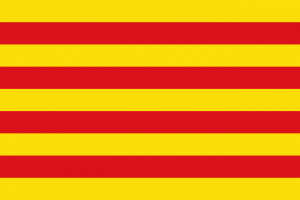Language/Catalan/Vocabulary/Common-Greetings
| ◀️ Basic Sentence Structure — Previous Lesson | Next Lesson — Introducing Yourself ▶️ |
Introduction[edit | edit source]
In this lesson, we will explore common greetings in Catalan. Greetings are an essential part of any language and culture as they serve as the foundation for basic conversations. By learning how to greet someone in Catalan, you will be able to start conversations, make connections, and show respect to the locals. In this lesson, we will cover various greetings such as "hello," "goodbye," and "how are you?". We will provide detailed explanations, examples, and cultural information to enhance your learning experience. So, let's get started and dive into the world of common greetings in Catalan!
Greetings in Catalan[edit | edit source]
"Hello" - "Hola"[edit | edit source]
The most common way to greet someone in Catalan is by saying "Hola." This greeting is suitable for both formal and informal situations. It is a versatile word that can be used to greet friends, family, colleagues, and strangers. Let's take a look at some examples:
| Catalan | Pronunciation | English Translation |
|---|---|---|
| Hola | ['ɔ.lə] | Hello |
- Hola, com estàs? (Hello, how are you?)
- Hola, bon dia! (Hello, good morning!)
- Hola, què tal? (Hello, how's it going?)
"Goodbye" - "Adéu"[edit | edit source]
When it's time to part ways or say goodbye, the common Catalan word used is "Adéu." This word can be used in both formal and informal settings. It's a simple and straightforward way to bid farewell to someone. Let's see some examples:
| Catalan | Pronunciation | English Translation |
|---|---|---|
| Adéu | [ə'dew] | Goodbye |
- Adéu, fins aviat! (Goodbye, see you soon!)
- Adéu, que vagi bé! (Goodbye, take care!)
- Adéu, ens veiem demà! (Goodbye, see you tomorrow!)
"How are you?" - "Com estàs?"[edit | edit source]
To inquire about someone's well-being or ask how they are doing, you can use the phrase "Com estàs?" in Catalan. This is a common greeting that shows interest and concern for the other person. Here are some examples:
| Catalan | Pronunciation | English Translation |
|---|---|---|
| Com estàs? | [kum əs'tas] | How are you? |
- Hola, com estàs? (Hello, how are you?)
- Com estàs avui? (How are you today?)
- Com estàs passant el dia? (How is your day going?)
"Nice to meet you" - "Encantat de conèixer-te"[edit | edit source]
When meeting someone for the first time, it's common to express pleasure or excitement by saying "Encantat de conèixer-te" in Catalan, which translates to "Nice to meet you" in English. This greeting is used to convey politeness and establish a friendly atmosphere. Let's see some examples:
| Catalan | Pronunciation | English Translation |
|---|---|---|
| Encantat de conèixer-te | [ən.kən'tat də ku.nəj'ʃe tek] | Nice to meet you |
- Encantat de conèixer-te, com et dius? (Nice to meet you, what's your name?)
- Encantat de conèixer-te, d'on ets? (Nice to meet you, where are you from?)
- Encantat de conèixer-te, què fas a Catalunya? (Nice to meet you, what are you doing in Catalonia?)
Cultural Insights[edit | edit source]
Greetings play a significant role in Catalan culture as they reflect the values of politeness, respect, and friendliness. The Catalan people take pride in their warm and welcoming nature, and greetings are an integral part of their daily interactions. It is customary to greet people with a smile, maintain eye contact, and use appropriate greetings based on the time of day and the level of familiarity.
In Catalonia, it is common to greet friends and family members with a kiss on both cheeks, while a firm handshake is more appropriate for formal or professional settings. It is also important to note that Catalan culture places importance on personal connections and building relationships, so taking the time to greet someone properly can go a long way in establishing a positive rapport.
Furthermore, regional variations may exist in the usage of greetings within Catalonia. For example, in Barcelona, the most populous city in Catalonia, greetings tend to be more formal and reserved compared to smaller towns and villages where people are often more relaxed and informal in their interactions. These subtle differences add richness and diversity to the Catalan language and culture.
Practice Exercises[edit | edit source]
Now that you have learned some common greetings in Catalan, let's put your knowledge into practice with a few exercises. Translate the following English phrases into Catalan:
1. Hello, how are you? 2. Goodbye, see you tomorrow! 3. Nice to meet you, what's your name? 4. How are you today? 5. Good morning, have a great day!
Solutions
1. Hola, com estàs? 2. Adéu, ens veiem demà! 3. Encantat de conèixer-te, com et dius? 4. Com estàs avui? 5. Bon dia, que tinguis un bon dia!
Conclusion[edit | edit source]
Congratulations! You have now learned some common greetings in Catalan. Greetings are an essential part of any language, and by mastering them, you will be able to initiate conversations, make connections, and show respect to the locals. Remember to practice these greetings in real-life situations to become more comfortable and confident in using them. Keep up the good work, and in the next lesson, we will delve into introducing yourself and others in Catalan. Fins aviat! (See you soon!)
Sources[edit | edit source]
- 14 Useful Catalan Words & Phrases for Expats | Barcelona Expat Life
- 20 Essential Catalan Phrases You'll Need in Barcelona
- Essential Catalan Phrases to visit like a local | Barcelona Eat Local ...
Other Lessons[edit | edit source]
- Family Members
- How to use "to speak" in Catalan
- Sports and Games
- Food Vocabulary
- Numbers 1 100
- Time
- Idiomatic Expressions
- Common nouns and verbs for daily life
- Directions
- Numbers
| ◀️ Basic Sentence Structure — Previous Lesson | Next Lesson — Introducing Yourself ▶️ |

